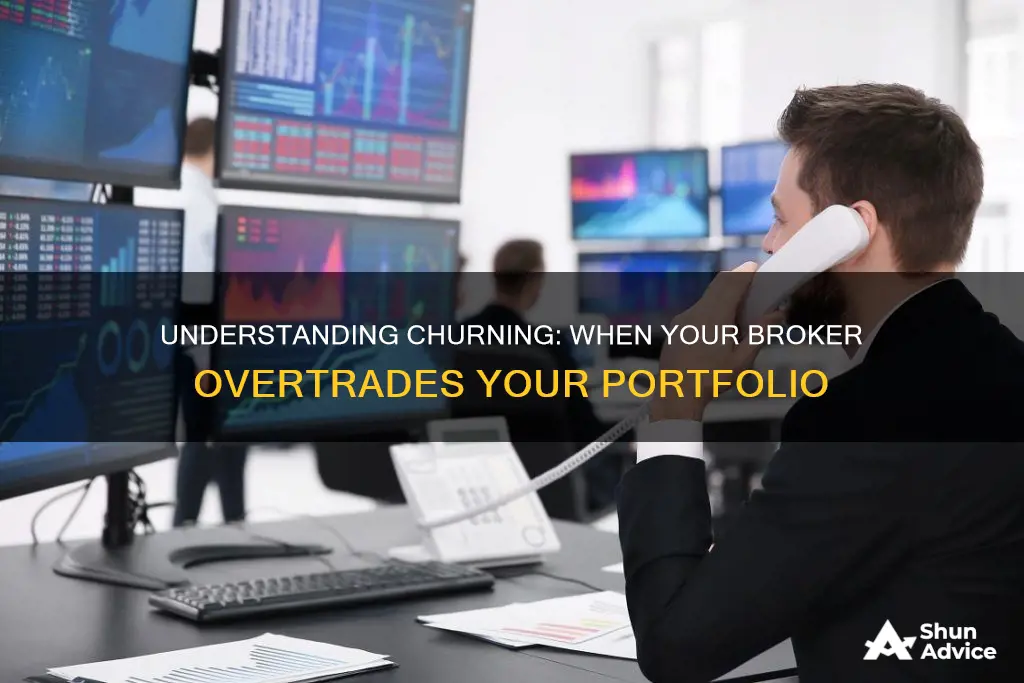
Churning is an unethical and illegal practice in investment portfolio management, where a broker or financial advisor excessively trades assets in a client's account to generate commissions. Churning occurs when a broker puts their interests ahead of the client's, violating their fiduciary duty to act in the client's best interest. While churning can lead to substantial losses in the client's account, it is challenging to detect and prove. Investors can protect themselves by staying involved in decision-making, carefully reviewing transactions and statements, and comparing fees and portfolio gains.
| Characteristics | Values |
|---|---|
| Definition | Churning is the illegal and unethical practice by a broker of excessively trading assets in a client's account in order to generate commissions. |
| Red flags | Unauthorized trading, frequent trading, and excessive fees. |
| Consequences | Churning can result in substantial losses in the client's account and increased tax liability. |
| Prevention | Investors can avoid churning by maintaining an active role in decision-making regarding their portfolios. |
| Proof | Churning is hard to spot. It may be indicated by frequent commission charges with no noticeable portfolio gains. |
| Sanctions | Churning is a serious offence and can lead to employment termination, barring from the industry, and legal ramifications. |
What You'll Learn

Churning is illegal and unethical
Churning is an illegal and unethical practice that can have serious financial consequences for clients. It is a type of broker misconduct where a broker or financial advisor excessively trades a customer's account to generate commissions, regardless of whether the trades are suitable for the client. Churning violates federal laws, industry regulations, and standards, and brokers are required to act as fiduciaries and always in the best interest of their clients.
Churning is unethical because it prioritizes the broker's financial gain over the client's best interests. The excessive trading generates higher commissions for the broker while providing little to no benefit to the investor. In some cases, churning may result in substantial losses in the client's account, even if the trades are profitable. Additionally, it may generate unnecessary tax liabilities for the client.
Churning is illegal and is subject to severe fines and sanctions. It is a violation of Securities and Exchange Commission (SEC) rules and is considered fraudulent activity. Brokers who engage in churning may face employment termination, barring from the industry, legal ramifications, and hefty fines. They may also be ordered to repay excess fees and compensate clients for investment losses caused by their misconduct.
To prevent churning, investors should maintain an active role in decision-making regarding their portfolios. They should carefully review account activities, transaction notices, and monthly statements, and be cautious when authorizing trades. By staying vigilant and informed, investors can protect themselves from the harmful effects of churning.
Investment Surpassing Savings: A Recipe for Economic Growth or Debt?
You may want to see also

Churning can lead to significant losses
Churning, the unethical and illegal practice of excessive trading in a client's account to generate commissions, can lead to significant financial losses for investors. This is because investors are typically charged a commission or a flat percentage fee for each trade, meaning they pay every time a broker makes a transaction. Even if these trades are profitable, churning can result in unnecessary tax liabilities for the investor, causing further losses.
For example, consider a case where a broker made over 350 trades in a client's account over a period of around 16 months, earning over $54,000 in commissions. For the investor to break even, their account would have needed to grow by over 158% annually. This example illustrates how churning can lead to substantial financial losses for investors, who may struggle to generate enough profit to cover the costs of frequent trades.
Churning can be challenging to identify, as the cost of trading is not always evident on trade confirmations. Brokerage firms may charge investors a "markup" or "markdown" instead of a commission, concealing trading costs. However, red flags of excessive trading may include unauthorized trades, frequent in-and-out purchases and sales, and excessive fees.
To prevent churning, investors can maintain control over their accounts and require their permission for any changes. They can also opt for fee-based accounts, which charge a percentage of assets under management and reduce the incentive for brokers to churn. However, fee-based accounts may not suit all investors, as low trading activity can lead to reverse churning, where fees eat into profits. Therefore, it is essential to specify expectations regarding portfolio management from the outset.
Savings-to-Investment Ratio: A Window to Your Financial Health
You may want to see also

Red flags of churning
Churning is an illegal and unethical practice that harms investors and the integrity of financial markets. It occurs when a broker or financial advisor excessively trades assets in a client's account to generate higher commissions or fees, regardless of the client's investment goals and interests. This results in substantial transaction costs, poor investment performance, and significant tax liabilities for the investor.
- Unauthorized Trading: Be cautious if you notice trades in your account that you did not authorize your broker to make.
- Frequent Trading: Be wary of frequent purchases and sales of securities that don't align with your investment goals, risk tolerance, and overall market trends.
- Excessive Fees: Be alert if the total fees seem disproportionately high or if a specific segment of your portfolio consistently attracts high fees.
- High Turnover Rates: FINRA and other regulators consider turnover rates of 6 or more as indicative of excessive trading.
- High Cost-Equity Ratios: Regulators view cost-equity ratios of 20% or more as a sign of excessive trading.
- Lack of Justification: If your broker, brokerage firm, or financial planner cannot provide valid reasons for the transactions, it may indicate churning.
- Inconsistent Product Switching: Be cautious if your wealth manager frequently switches between different types of financial products, such as mutual funds, unit trusts, and annuities, without a clear strategy.
Cash in Investment Portfolios: Asset or Liability?
You may want to see also

How to prove churning
Churning is a type of broker misconduct, which can have serious financial consequences for their clients. It is an unethical and illegal practice where a broker excessively trades assets in a client's account to generate commissions.
- Request to discuss transactions in advance: You can ask your broker to discuss any buy or sell transactions with you in advance. While this can be signed away when opening an account, it is not mandatory to do so.
- Review written notifications: Whether or not you discuss transactions with your broker in advance, you will receive a written notification of every transaction, which is a federal requirement. If you are receiving these notifications daily or weekly, it could indicate churning, especially if the transactions involve mutual funds, annuities, or insurance products.
- Monitor commission charges: Review your monthly statements to check how much you are paying in commissions. High commission costs without corresponding profits may be a sign of churning.
- Compare your account performance to the market: If the market is moving upward but your account is declining, it may be due to the commissions resulting from excessive trading.
- Unauthorized trading: Be cautious if you notice trades in your account that you did not authorise your broker to make.
- Excessive fees: Be suspicious if the total amount of fees seems high or if a specific segment of your portfolio consistently generates high fees.
If you suspect churning, you can report it to regulatory bodies such as the Securities and Exchange Commission (SEC) or the Financial Industry Regulatory Authority (FINRA).
Saving and Investing: Building Wealth and Security
You may want to see also

Sanctions for churning
Churning is a serious financial misconduct and can lead to severe sanctions for those found guilty. The Securities and Exchange Commission (SEC) and the Financial Industry Regulatory Authority (FINRA) investigate complaints and impose sanctions on brokers who engage in churning. These sanctions can include fines, suspension, or permanent bans from the industry.
The SEC defines churning as excessive trading in a customer's account, controlled by the broker, with the purpose of generating increased commissions. This practice is in violation of SEC Rule 15c1-7, which governs manipulative and deceptive conduct. The SEC considers this a fraudulent action and can result in fines ranging from $5,000 to $116,000. Additionally, the FINRA may suspend the broker for a period ranging from one month to two years, or even impose a permanent ban for more severe cases.
Churning is an unethical and illegal practice that can cause significant financial harm to clients. It is important for investors to be vigilant and monitor their accounts regularly to detect any signs of churning. High commission fees, frequent trades that do not align with investment goals, and poor portfolio performance can be indicators of churning. If investors suspect churning, they should report it to regulatory bodies like the SEC or FINRA for further investigation and potential sanctions against the broker.
Investors who have been victims of churning can take legal action and hold their brokers liable for investment losses, as well as the commissions and costs associated with the trades. It is crucial for investors to carefully review their account activity, transaction confirmations, and monthly statements to identify any suspicious trading patterns or excessive fees that could indicate churning.
Investing vs. Saving: Brainly's Guide to Financial Strategies
You may want to see also
Frequently asked questions
Churning an investment portfolio refers to the changes investors make to their portfolio in response to market conditions. This includes buying and selling holdings and deciding to keep certain investments to yield better returns. Churning can also refer to the unethical and illegal practice of a broker excessively trading assets in a client's account to generate commissions.
Investors churn their portfolios by buying and selling holdings based on their view of the market, sector, and the underlying business. This can be done to take advantage of market conditions or to move away from companies or sectors that may be disrupted.
Churning can have both positive and negative impacts on investment portfolios. On the one hand, it can help investors take advantage of market opportunities and avoid potential disruptions. On the other hand, excessive churning can lead to short-term thinking, high transaction fees and taxes, and a negative impact on the financial future of the investor due to imprudent investments and excessive commissions.
Investors can avoid the negative consequences of churning by taking a long-term perspective, being selective about their trades, and maintaining an active role in decision-making regarding their portfolios. Additionally, investors should monitor their accounts closely and be cautious about frequent trades that do not align with their investment goals.







